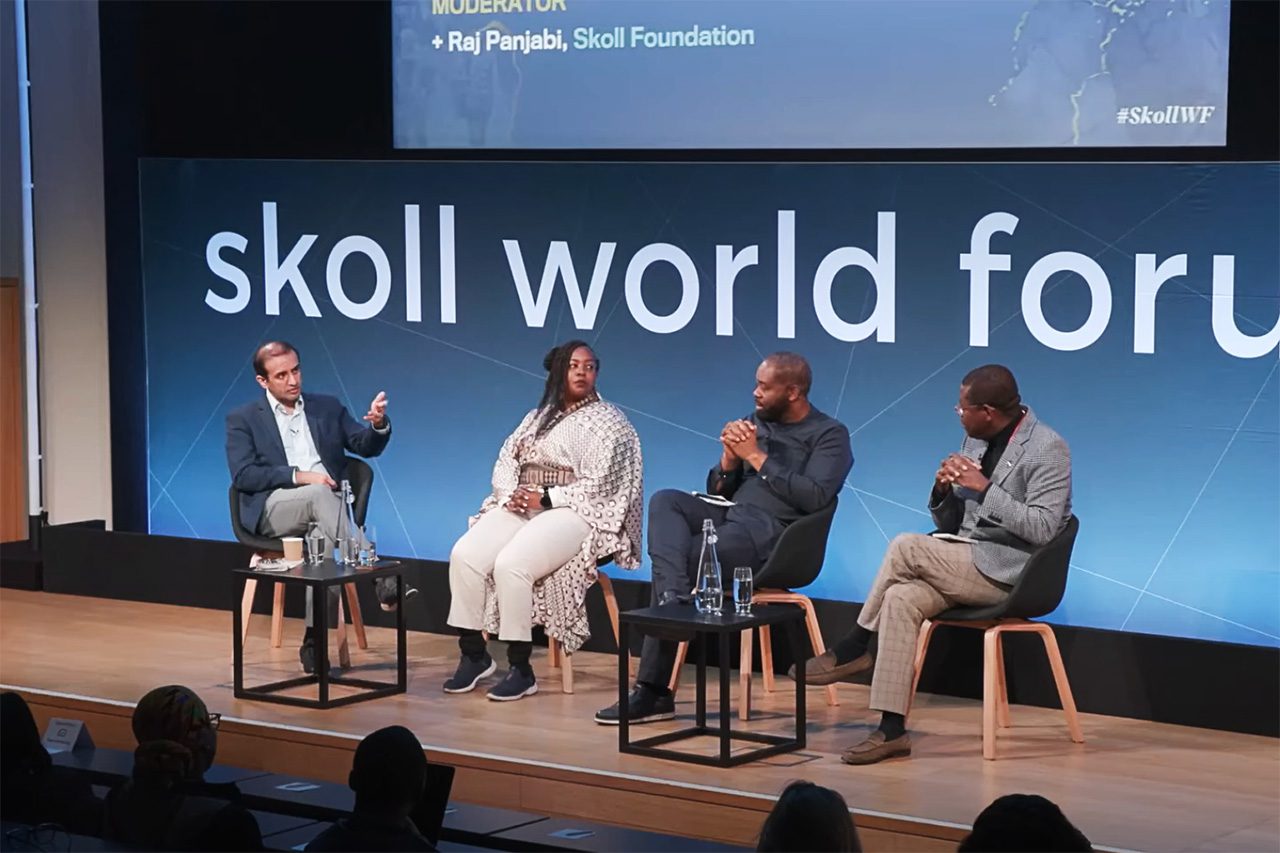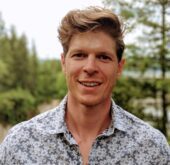Sovereign Seeds: Reclaiming MENA’s Agricultural Future
Reviving local food systems and unlocking rural prosperity
Bold innovations in funding health systems

(From left) Raj Panjabi, Angela Gichaga, Dr. Kelechi Ohiri, Bright Simons
Oxford, April 2025. Inside the vaulted Sheldonian Theatre at this year’s Skoll World Forum, a standing room only crowd gathered for “Resourcing Resilience Across Africa.” Moderated by Raj Panjabi, the conversation brought together health system innovators from Nigeria, Kenya, and Ghana to tackle one urgent question: how can African nations plug widening funding gaps as traditional donors retreat? The insights below draw directly from that session.
Over the past several decades, there has been notable progress in global health. Maternal mortality has declined by 40%, infant mortality by 25%, and deaths from HIV, tuberculosis, and malaria have dropped by 60%. However, these hard-won gains are now under serious threat. High-income countries — historically the largest donors of global health aid — are retreating from their commitments.
The United States, for instance, has significantly reduced USAID funding to the World Food Program and withdrawn support for life-saving medications in low-income countries, particularly in the Global South. The United Kingdom has reallocated development aid to bolster defense spending. And the list of such retrenchments continues to grow.
Dr. Kelechi Ohiri of the Nigerian National Health Insurance Agency has highlighted Nigeria’s efforts to confront the financial strain caused by the withdrawal of USAID funding. Drawing from a historical perspective, Dr. Ohiri notes a significant shift in the burden of disease: whereas it previously affected roughly one-sixth of the population, today nearly one-third is among the most acutely impacted.
He observes that development assistance continues to decline, prompting an increased reliance on co-payments from both citizens and the government. Compounding this challenge is Nigeria’s growing demographic complexity — marked by a simultaneous youth bulge and rising life expectancy. As a result, the country faces a dual pressure: a younger population rich in human capital but limited in financial resources, and an aging population increasingly dependent on a shrinking financial base.

(From left) Raj Panjabi, Angela Gichaga, Dr. Kelechi Ohiri, Bright Simons
Further exacerbating the situation are the lingering effects of the COVID-19 pandemic, high inflation, falling commodity prices, and sluggish economic growth. The recent wave of international aid cuts represents yet another shock to a system already under considerable stress.
As an initial response to the funding shock, Nigerian authorities have moved quickly to absorb the impact and begin mitigation efforts. The National Assembly of the Federal Republic of Nigeria approved a supplementary budget of $200 million to support the employment of 12,000 voluntary health workers — a partial replacement for the 23,000 workers previously fully funded through now-defunded international programs.
To address resource constraints, the government is also prioritizing efficiency by streamlining supply chains, conducting internal evaluations, and enhancing operational effectiveness. According to Dr. Ohiri, the current plan reflects a new reality — there is no return to the previous status quo. Central to this strategy is the introduction of a Minimum Benefit Package (MBP) that integrates services for HIV, tuberculosis, and malaria into a unified, more efficient delivery platform — a deliberate effort to “build back better.”
Additional responses include channeling resources through in-country partners and adopting an “Africa Frontline First” approach, alongside pooled procurement mechanisms. Angela Gichaga of the Financing Alliance for Health in Kenya further proposed innovative financial strategies such as debt restructuring, conversion, and refinancing to free up resources for essential sectors like healthcare. She also underscored the critical role of private sector participation in advancing these reforms.

(From left) Raj Panjabi, Angela Gichaga, Dr. Kelechi Ohiri, Bright Simons
Angela Gichaga also proposed the adoption of innovative financing mechanisms to tap into the potential of remittance flows — which, in many countries, surpass foreign aid by more than a multiple of one. Although remittances are typically directed toward individual and household needs, she argued that a portion could be leveraged to address broader social and collective challenges at the national level. As an example, she cited Rwanda, where a government-managed fund channels part of remittance inflows toward public programs.
Dr. Kelechi Ohiri echoed this perspective by highlighting the Nigerian context, where annual remittances now exceed $35 billion. He noted that efforts are underway to launch a Diaspora Health Initiative aimed at harnessing these funds to strengthen the country’s health system.
Responsibility for accountability must shift from donors to the beneficiaries themselves, who ultimately bear the consequences of success or failure.
Bright Simons strongly advocated for the prioritization of localized solutions, identifying the lack of localization as a key reason for the persistent difficulty in assessing and measuring the impact of certain global health programs on the ground. He emphasized the critical role of domestic actors in the aid ecosystem, arguing that innovation most often emerges at the local level — where experimentation, accountability, and responsiveness to context are more feasible and effective.
As a case in point, Simons noted that USAID had long set a target of allocating 25% of its budget to local partners and contractors. However, despite this stated goal, it consistently failed to meet the benchmark. In its final assessment before the initiative was discontinued, spending through local partners remained below 10%.
In Simons’s view, this shortfall reflects a broader and more troubling issue: a persistent and substantial gap between domestic and foreign actors in the aid industry — a divide that must be bridged if development efforts are to be truly effective and sustainable.
As a further illustration, Bright Simons pointed to the Global Fund, which operates without in-country offices and instead relies on local fund agents — often drawn from the Big Four global professional service firms. However, the reports generated by these agents are typically not shared with domestic actors, making it difficult to align on priorities or build shared perspectives. In theory, the interests of local stakeholders are represented through Country Coordination Mechanisms (CCMs), committees intended to reflect a broad range of civil society voices. Yet, based on Simons’s nearly two decades of activism in Ghana, he has never engaged with a CCM — nor, he noted, has he encountered any prominent local civil society partners who have worked with these bodies. He cited a specific example in which a shipment took over a year to clear Ghanaian ports — far exceeding the typical two-month timeframe — due to the CCM’s inability to exert sufficient domestic influence amid the complexities of Ghana’s political economy.
The concept of healthcare must be redefined to encompass a broader range of stakeholders and a more diverse set of outcomes.
Simons argued that the responsibility for accountability must shift from donors to the beneficiaries themselves, who ultimately bear the consequences of success or failure. “Who are these entities solving for?” he asked. Re-centering accountability at the local level — among the communities and individuals directly impacted — would go a long way toward resolving the agency problem that continues to undermine global health efforts.
According to Bright Simons, despite widespread aid cutbacks, Africa still has the potential to triple the volume of global health resources at its disposal by accelerating the disbursement of already committed funds from Multilateral Development Banks. Realizing this potential will require faster and more effective program execution — which, in turn, depends on streamlined compliance with essential governance requirements.
Simons also emphasized the importance of improving the allocation efficiency of counterpart funding from African governments. By enhancing the speed and reliability of these domestic contributions, countries can accelerate project preparation, improve bankability, and unlock stalled financial flows for critical health initiatives.
The concept of healthcare must be redefined to encompass a broader range of stakeholders and a more diverse set of outcomes. As Bright Simons aptly asked, “How much of the gains in global health can truly be attributed to clinical interventions, and how much to social determinants such as nutrition and sanitation?” This crucial question is too often overlooked, resulting in fragmented and poorly coordinated investments across vital development inflection points.
To shape its own future, Africa must strengthen internal cohesion and reclaim agency over its development trajectory. At the same time, the global community must recognize the continent not as a charity case, but as a compelling business opportunity — energized by its vast demographic potential.
Simons also highlighted the paradox of what he termed “fiscal essentialism” among African leaders — a tendency to prioritize hard infrastructure (roads, buildings, equipment) over soft infrastructure (standards, governance, innovation). Yet without the institutional and technical capacity to translate brick-and-mortar investments into productive assets, such projects risk becoming liabilities, feeding debt rather than driving growth. Investments in governance systems and innovative capacity — the soft underbelly of sustainable development — must no longer be treated as peripheral. They are central to any lasting transformation and to moving beyond aid dependency.
Equally urgent is the inclusivity challenge. This can only be addressed, in Simons’s view, when the hard and soft dimensions of development are “more effectively synced.” The ability of African governments to design and deliver inclusive programs for society’s most vulnerable — including Internally Displaced Persons (IDPs), Persons with Disabilities (PWDs), and the elderly — increasingly depends on this integrative approach, especially in a context of declining reliance on Western aid.
Ultimately, a whole-of-society approach is essential to safeguard and build upon the gains achieved through decades of global health investment. The path forward demands bold innovation, institutional maturity, and a firm commitment to inclusive, locally led development.
Related Content
Comments
Deep Dives

Featuring
Clarisse Awamengwi
IE Correspondent
July 17 - 12:00 PM EST

Featuring
Russell McLeod
July 24 - 12:00 PM EST
RECENT
Editor's Picks
Webinars
News & Events
Subscribe to our newsletter to receive updates about new Magazine content and upcoming webinars, deep dives, and events.
Become a Premium Member to access the full library of webinars and deep dives, exclusive membership portal, member directory, message board, and curated live chats.
At Impact Entrepreneur, we champion fearless, independent journalism and education, spotlighting the inspiring changemakers building the Impact Economy. Diversity, equity, sustainability, and democracy face unprecedented threats from misinformation, powerful interests, and systemic inequities.
We believe a sustainable and equitable future is possible—but we can't achieve it without your help. Our independent voice depends entirely on support from changemakers like you.
Please step up today. Your donation—no matter the size—ensures we continue delivering impactful journalism and education that push boundaries and hold power accountable.
Join us in protecting what truly matters. It only takes a minute to make a real difference.
0 Comments